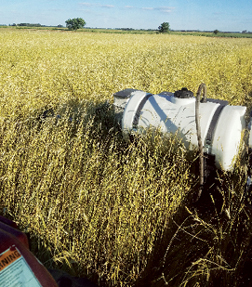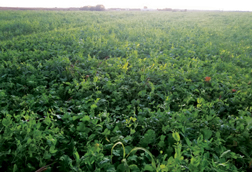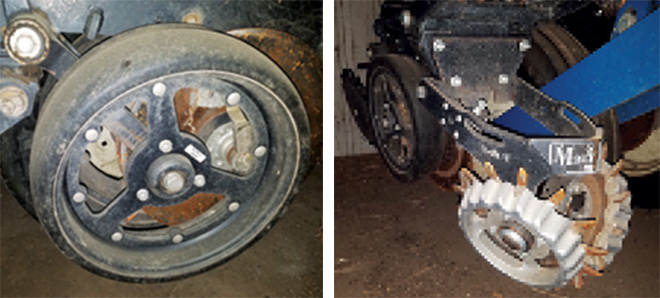
Chris Nissen
Check The Specs...
NAME: Chris and Dick Nissen
LOCATION: Vermillion, S.D.
FARM: Nissen Farms
YEARS NO-TILLING: 20
ACRES: 900 acres
CROPS: Corn, Soybeans, Winter Wheat
Our farm hit a plateau in the 1990s. Yields were flat and we just weren’t making the gains we thought we should be. It’s not that we sought out no-till as the magic solution; we just knew we had to try something different, as conventional tillage wasn’t cutting it.
As it turns out, no-till was the right move. While it may not be magic, it certainly got us moving in the right direction again. This forward momentum can be attributed to no-till improving our dense soils and how we manage them.
Just like everyone else in the region, we used to work the ground heavily — chisel plowing and discing in the fall, then cultivating and discing in the spring prior to planting. Over 50% of our ground is river bottom, of which 160 acres are irrigated. The rest of our acres are dryland and up on some slight hills and valleys.
At the time, we didn’t have much tile drainage so we were relying on surface drainage to manage our rains and allow us to get in the fields. Unfortunately, our clay loam soils just don’t drain very well, and in hindsight, we can see that our farming practices weren’t helping the situation either. By working the soil so much, we were creating a nice seal in our fields, preventing water from getting into our soils or moving off our fields.
It seemed like our fields were always wet. This created issues at planting and during the growing season and certainly wasn’t doing us any favors in the yield department.
In the late 1990s we hit a point where almost all our equipment needed to be replaced. Instead of swapping it out for more conventional equipment, we purchased a Flexi-Coil air seeder and an 8-row Kinze no-till planter. We eliminated the expense of owning a disc and having to operate it, so that was good initial incentive. We were among the first to no-till in our area, so we weren’t sure how it would all turn out.
Trial by Water
Our first year of no-till planting went smoothly. Rains were timely so we were able to get in the field right alongside our neighbors and our yields were comparable. The next couple years put us to the test. We had wet springs. While our neighbors could work the soil to dry it out, we had to wait an excruciating 3-4 weeks before we could get in the field. Though stressful, our crops those years ended up being even with everyone else’s in yield.

MOISTURE MANAGERS. On acres where the Nissens can’t tile or include wheat in their rotation, they seed a cereal rye cover crop. The growing plant helps manage water at planting and its roots build soil
Back then it was tough in the spring to watch the neighbors out and going in the fields, but now it’s kind of fun to watch them spinning their wheels while we just wait until the ground is ready. Now, however, water is less of an issue for us so we’re never too far behind our neighbors in the spring.
As our soil structure improved with years of no-till, we’ve found we can plant into wetter conditions than our conventional neighbors. Our soils are strong, holding up the planter and the tractor better. We especially see this on our river bottom acres where tiling isn’t an option.
In 2016, there was a 7-mile stretch of river bottom ground where ours were the only acres able to be planted due to a very wet spring. Conventionally farmed ground on either side of us had water sitting on the fields and had to eventually be prevent planted. When I was planting, I turned a little late and ended up in a field bordering ours. I left 2-foot deep ruts, but when I got turned around and headed into our field, the tractor came right back up and I continued on.
We’ve actively drain tiled a lot of our hill ground, doing more each year as finances allow. We’re pattern tiling at 120-foot intervals with 6-inch tile.
Tiling combined with the great soil structure no-till and cover crops provide seems to be working well for us. This past planting season it was super wet and we were farming while the neighbors were sitting still. This fall we had 7 inches of rain in the span of a couple weeks. Our drain tiles were running full while tiled conventional fields were running about half and you could see water standing in the rows.
The 7.5-inch spacing on the drill, as compared to the 30-inch spacing on the planter, gives us a faster canopy to keep ahead of the weeds…
Cover Benefits
Cover crops are something we’ve worked into our no-till system in the past 6 years. They were something we had heard about extensively at no-till meetings and seen others having success with, so we decided to give them a try on our farm.
We raise winter wheat so that gave us an excellent opportunity to seed a cover crop and get a lot out of it. The first time we tried it we had radishes, turnips and lentils commercially drilled. The corn we grew on those acres the following year yielded 5 bushels more per acre than adjacent fields with the same conditions, minus the cover crops. Since then we were pretty much sold on cover crops.
Besides yield we noticed our corn stayed greener all summer long than where we hadn’t used a cover crop. I think it was a combination of scavenging nitrogen (N) and keeping soil microbes fed and happy. Now we try to make sure we plant winter wheat strategically so we can get a cover crop on each acre every 3 years.
Our typical rotation is corn-soybeans-wheat and cover crops. Our mix is now radishes, turnips, lentils and forage peas. We also use this mix to help speed up soil recovery from installing tile. Tile usually goes in after winter wheat. We level off the ridges with a box scraper and plant the cover crop. It seems to keep the ground mellow and gets rid of the ridge pretty quickly.
We have some acres that are classified as wetlands and cover crops have made a huge difference in managing water on those acres.
There are deviations in our cover crop program. We rent some ground where the landlord doesn’t want us to plant wheat. On those acres we seed cereal rye after soybeans. It helps keep roots in the ground and dry up those acres a little quicker in the spring.
Grazing Boost
Winter wheat itself has had a steady slot in our rotation for at least 8 years now. We’ve observed that we get significant jumps in our yields following wheat as opposed to just a corn-soybean rotation.
We used to sell straw from the crop to help offset the lower price of wheat. The crop itself, selling straw and the bump in yields we got the following year made it well worthwhile. Now we have yet another revenue stream for those acres.
Once we added cover crops to our rotation, a neighbor with cows saw a grazing opportunity. We started leasing our cover crop acres to him to graze. This year we harvested the wheat July 17, planted our cover crop Aug. 1 and the cows were turned out the first week of September.

GRAZING OPTIONS. With commodity prices less than ideal, the Nissens tried seeding a 12-way cover-crop mix in the spring for forage. They reaped soil health benefits and harvested two cuttings of hay before leasing grazing of the regrowth. Cereal rye was seeded into the mix this fall for forage next spring.
We planted 40 pounds per acre of forage peas, radish, lentils and turnips. The radishes and turnips were about 8-10 inches tall when the cattle started grazing and there was some winter wheat regrowth.
This spring we also experimented with a 12-species pasture cover-crop mix that included radishes, turnips, red clover, millet, oats and sudangrass on 26 acres. We harvested two cuttings and then leased out grazing on the regrowth.
With the crop price outlook not looking great, we thought this would be a better use of these acres since we would be building soils and generating revenue. We went back in late September and seeded cereal rye into the mix with the goal of harvesting it for forage next spring prior to planting soybeans.
This is only our second year with cows in the rotation, but we’ve seen yields go up and our volunteer pressure from corn and wheat in the following crop has decreased.
While we are removing that vegetation, which can be seen as a negative for purists, in talking with Dakota Lakes Research Farm director Dwayne Beck, it would seem the cattle are also working organic matter into the soil with hoof traffic and manure, which allows the soil microbes to work on it a little more. We’ve been happy with the results.
Last year we planted some soybeans after cover crops and they yielded 105 bushels per acre, a farm record. We’re normally in the 60- to 70-bushel range. We’re definitely going to look at seeding soybeans after our cover-crop mix in certain situations where it makes sense in our rotation.
The crops are certainly reflecting an increase in soil health due to no-till and cover crops. The root mass in the ground has built our organic matter from 1.5% to 2%.
I think the best things we have going for us on our farm is our three-crop rotation and our use of cover crops. If I’m taking over a new farm that’s been conventionally tilled, our setup seems to improve the soil structure so much faster than just no-till corn and soybeans.
Ours definitely isn’t the most common setup for the area — we probably raise half the wheat in Clay County — but it works for us. In 2016, we raised 95-bushel wheat and had grazing income. The cattle have thrived on the cover crops and have put on some weight. We get paid by the month and hope to leave them in until February.
Mud Management
Even with tile drainage, no-till and cover crops, we often end up planting into some fairly wet conditions due to the level of rain we receive. We currently run two 8-row Kinze corn planters and outfit them accordingly.
Our planters are fitted with floating Martin row cleaners and MudSmith gauge wheels. We’ve been using these gauge wheels for the past 5 years. They look like normal gauge wheels, but the centers have large holes cut in them. These holes allow the mud from the disc opener to fall out of the wheel instead of building up. With our old gauge wheels we would plug up constantly.

MASTERING MUD. The Nissens run Martin row cleaners, MudSmith gauge wheels (left) and either Schlagel Posi Close or Furrow Cruiser spiked closing wheels on their two Kinze planters. The MudSmiths, which have holes that allow mud to fall through, don’t plug up like their previous gauge wheels did.
When the mud falls out there is less resistance so the wheel continues to work properly, allowing us to plant more accurately in less-than-ideal planting conditions.
We use two setups for closing the trench. One planter uses Schlagel Posi Close wheels, which are bent metal fingers. The other planter uses Furrow Cruiser spiked closing wheels, which have shorter, straight poly spikes. The Schlagel wheels seem to do better when it’s wet and we see better germination. If my dad, Dick, and I are both out planting and a field is a little wetter, we’re sure to use the Schlagel-equipped planter on those acres.
Our drill is pretty basic. We opted to get rid of the Flexi-Coil air seeder for a Great Plains minimum-till disc drill. There’s far less maintenance and it does an excellent job of seeding our winter wheat and cover crops. We also use it to seed soybeans on occasion. When we’re dealing with slightly wetter conditions, the 7½-inch spacing on the drill, as compared to the 30-inch spacing on the planter, gives us a faster canopy to keep ahead of the weeds. With either spacing we shoot for a population of 145,000.
The planter does allow us some more management options, though. We use the starter setup on the planter to apply Headline fungicide in furrow. It only costs us about $3 per acre and it gives us added peace of mind. Plus, if we were to apply the fungicide later it would require us to spend $7 per acre for the sprayer plus $3 per acre for the fungicide.
Weed Barrier
Unfortunately, we’ve seen glyphosate-resistant waterhemp move aggressively into our area and we had a really bad year dealing with it in 2016. We’ve had to hit it pretty hard with a variety of herbicides to keep ahead of it, but we’re hoping we can get ahead of it with a few tweaks to our current program.
First off we’re going to switch to LibertyLink soybeans to see if we can hit it with a different chemical and eliminate it for a while. We’re also hoping our cover crops and winter wheat will allow us to keep it in check as we’re able to use different herbicides at different times.
The winter wheat is also growing at a different time and competes with the waterhemp. We’re considering using some more cereal rye cover too, as the thick residue should help suppress it.
Every year brings its own set of challenges, but we’re steadily making progress. Not only have we recorded our highest yields ever with soybeans, but we’ve also seen our corn yields steadily climb without increasing our fertilizer and N rates.
We watch our neighbors spread more and more fertilizer and get the same yields we get, and our yields are consistently going up. We apply about 160 units of N for a yield goal of 180-200 bushels per acre.
Thanks to no-till, cover crops and our diverse rotation, our farm is definitely out of its yield rut.







Post a comment
Report Abusive Comment